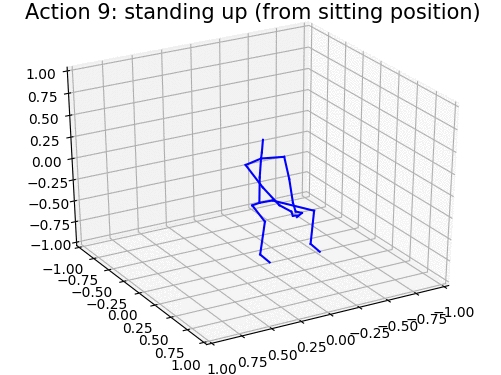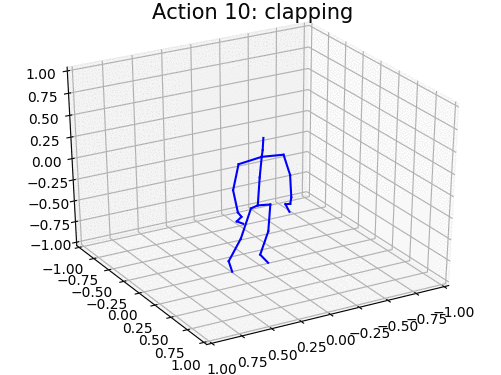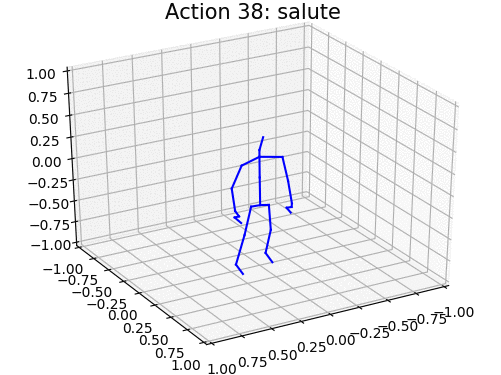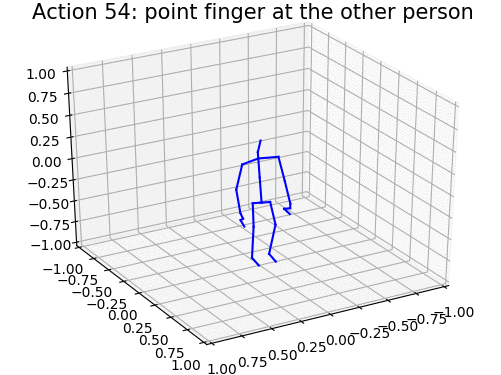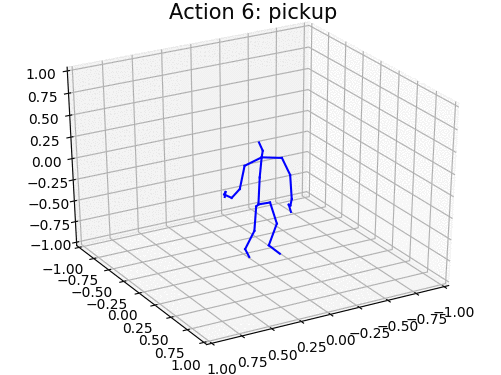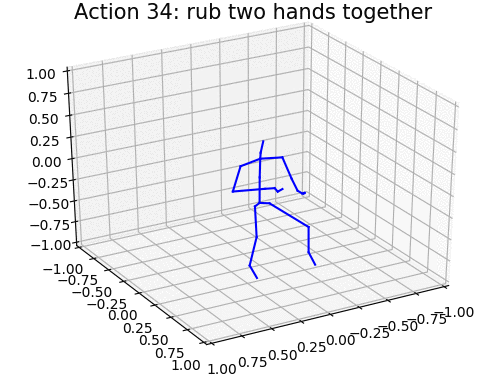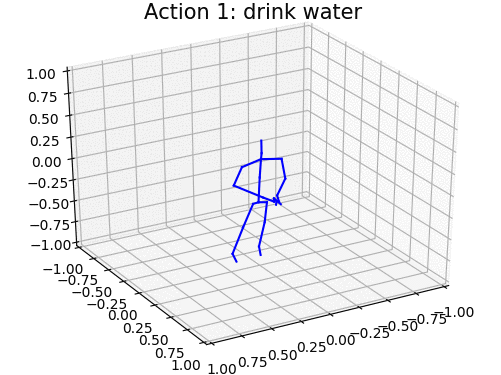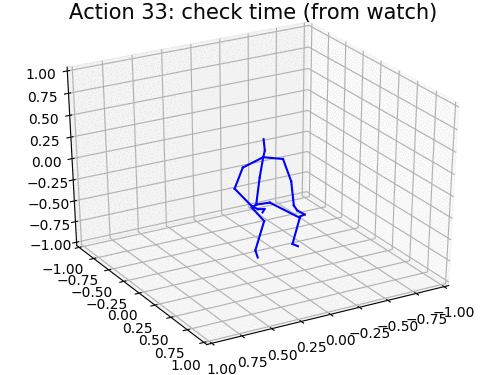PyTorch implementation of "Disentangling and Unifying Graph Convolutions for Skeleton-Based Action Recognition", CVPR 2020 Oral.
[PDF][Demo][Abstract/Supp]
- Python >= 3.6
- PyTorch >= 1.2.0
- NVIDIA Apex (auto mixed precision training)
- PyYAML, tqdm, tensorboardX
Disk usage warning: after preprocessing, the total sizes of datasets are around 38GB, 77GB, 63GB for NTU RGB+D 60, NTU RGB+D 120, and Kinetics 400, respectively. The raw/intermediate sizes may be larger.
There are 3 datasets to download:
- NTU RGB+D 60 Skeleton
- NTU RGB+D 120 Skeleton
- Kinetics 400 Skeleton
-
Request dataset here: http://rose1.ntu.edu.sg/Datasets/actionRecognition.asp
-
Download the skeleton-only datasets:
nturgbd_skeletons_s001_to_s017.zip(NTU RGB+D 60)nturgbd_skeletons_s018_to_s032.zip(NTU RGB+D 120, on top of NTU RGB+D 60)- Total size should be 5.8GB + 4.5GB.
-
Download missing skeletons lookup files from the authors' GitHub repo:
-
NTU RGB+D 60 Missing Skeletons:
wget https://raw.githubusercontent.com/shahroudy/NTURGB-D/master/Matlab/NTU_RGBD_samples_with_missing_skeletons.txt -
NTU RGB+D 120 Missing Skeletons:
wget https://raw.githubusercontent.com/shahroudy/NTURGB-D/master/Matlab/NTU_RGBD120_samples_with_missing_skeletons.txt -
Remember to remove the first few lines of text in these files!
-
- Download dataset from ST-GCN repo: https://github.com/yysijie/st-gcn/blob/master/OLD_README.md#kinetics-skeleton
- This might be useful if you want to
wgetthe dataset from Google Drive
Put downloaded data into the following directory structure:
- data/
- kinetics_raw/
- kinetics_train/
...
- kinetics_val/
...
- kinetics_train_label.json
- keintics_val_label.json
- nturgbd_raw/
- nturgb+d_skeletons/ # from `nturgbd_skeletons_s001_to_s017.zip`
...
- nturgb+d_skeletons120/ # from `nturgbd_skeletons_s018_to_s032.zip`
...
- NTU_RGBD_samples_with_missing_skeletons.txt
- NTU_RGBD120_samples_with_missing_skeletons.txt
-
NTU RGB+D
cd data_genpython3 ntu_gendata.pypython3 ntu120_gendata.py- Time estimate is ~ 3hrs to generate NTU 120 on a single core (feel free to parallelize the code :))
-
Kinetics
python3 kinetics_gendata.py- ~ 70 mins to generate Kinetics data
-
Generate the bone data with:
python gen_bone_data.py --dataset ntupython gen_bone_data.py --dataset ntu120python gen_bone_data.py --dataset kinetics
-
Download pretrained models for producing the final results on NTU RGB+D 60, NTU RGB+D 120, Kinetics Skeleton 400: [Dropbox][GoogleDrive][WeiYun]
-
Put the folder of pretrained models at repo root:
- MS-G3D/
- pretrained-models/
- main.py
- ...
- Run
bash eval_pretrained.sh
- The general training template command:
python3 main.py
--config <config file>
--work-dir <place to keep things (weights, checkpoints, logs)>
--device <GPU IDs to use>
--half # Mixed precision training with NVIDIA Apex (default O1) for GPUs ~11GB memory
[--base-lr <base learning rate>]
[--batch-size <batch size>]
[--weight-decay <weight decay>]
[--forward-batch-size <batch size during forward pass, useful if using only 1 GPU>]
[--eval-start <which epoch to start evaluating the model>]
- The general testing template command:
python3 main.py
--config <config file>
--work-dir <place to keep things>
--device <GPU IDs to use>
--weights <path to model weights>
[--test-batch-size <...>]
- Template for joint-bone two-stream fusion:
python3 ensemble.py
--dataset <dataset to ensemble, e.g. ntu120/xsub>
--joint-dir <work_dir of your test command for joint model>
--bone-dir <work_dir of your test command for bone model>
-
Use the corresponding config files from
./configto train/test different datasets -
Examples
- Train on NTU 120 XSub Joint
- Train with 1 GPU:
python3 main.py --config ./config/nturgbd120-cross-subject/train_joint.yaml
- Train with 2 GPUs:
python3 main.py --config ./config/nturgbd120-cross-subject/train_joint.yaml --batch-size 32 --forward-batch-size 32 --device 0 1
- Train with 1 GPU:
- Test on NTU 120 XSet Bone
python3 main.py --config ./config/nturgbd120-cross-setup/test_bone.yaml
- Batch size 32 on 1 GPU (BS 16 per forward pass by accumulating gradients):
python3 main.py --config <...> --batch-size 32 --forward-batch-size 16 --device 0
- Train on NTU 120 XSub Joint
-
Resume training from checkpoint
python3 main.py
... # Same params as before
--start-epoch <0 indexed epoch>
--weights <weights in work_dir>
--checkpoint <checkpoint in work_dir>
-
It's recommended to linearly scale up base LR with > 2 GPUs (https://arxiv.org/pdf/1706.02677.pdf, Section 2.1) to use 16 samples per worker during training; e.g.
- 1 GPU:
--base-lr 0.05 --device 0 --batch-size 32 --forward-batch-size 16 - 2 GPUs:
--base-lr 0.05 --device 0 1 --batch-size 32 --forward-batch-size 32 - 4 GPUs:
--base-lr 0.1 --device 0 1 2 3 --batch-size 64 --forward-batch-size 64
- 1 GPU:
-
Unfortunately, different PyTorch/CUDA versions & GPU setups can cause different levels of memory usage, and so you may experience out of memory (OOM) on some machines but not others
- 1080Ti GPUs with
--halfand--amp-opt-level 1(default) are relatively more stable
- 1080Ti GPUs with
-
If OOM occurs, try using Apex O2 by setting
--amp-opt-level 2. However, note that- NVIDIA Apex does not yet support
nn.DataParallelfor O2- NVIDIA/apex#227 (comment)
- This means you may need to train on a single GPU when using O2
- It may also impact the stability of training and/or the final performance
- NVIDIA Apex does not yet support
-
Default hyperparameters are stored in the config files; you can tune them & add extra training techniques to boost performance
-
The best joint-bone fusion result may not come from the best single stream models; for example, we provided 3 pretrained models for NTU RGB+D 60 XSub joint stream where the best fusion performance comes from the slightly underperforming model (~89.3%) instead of the reported (~89.4%) and the slightly better retrained model (~89.6%).
This repo is based on
Thanks to the original authors for their work!
Please cite this work if you find it useful:
@inproceedings{liu2020disentangling,
title={Disentangling and Unifying Graph Convolutions for Skeleton-Based Action Recognition},
author={Liu, Ziyu and Zhang, Hongwen and Chen, Zhenghao and Wang, Zhiyong and Ouyang, Wanli},
booktitle={Proceedings of the IEEE/CVF Conference on Computer Vision and Pattern Recognition},
pages={143--152},
year={2020}
}
Please email kenziyuliu AT outlook.com for further questions
